The iPhone 7 and iPhone 7 Plus Review: Iterating on a Flagship
by Joshua Ho & Brandon Chester on October 10, 2016 8:00 AM EST- Posted in
- Smartphones
- Apple
- Mobile
- iOS
- iOS 10
- iPhone 7
- iPhone 7 Plus
System Performance
Section by Brandon Chester
At the heart of a smartphone lies the SoC. While there's now an increasingly common belief that specifications don't matter, the truth of the matter is that almost all of the software features that users now take for granted in a smartphone have only been made possible by the continued improvements in hardware performance. Modern smartphones with high resolution displays and complex interfaces would not exist if the available CPU and GPU processing power hadn't advanced as much as it has. On top of that, performance is something of a gating factor for software development, as the innovation that happens in software has to happen within the boundaries of what can be done with the hardware. Specifications in a smartphone actually matter quite a lot, even if the user isn't actively aware of all the individual components that make up their smartphone's SoC.
With the iPhone 7 Apple doesn't have the benefit of a new major process node to help improve performance. Any improvements will be the result of architectural improvements, as well as improvements that have been made to TSMC's 16nm process since the release of the Apple A9, which was Apple's first FinFET SoC. It's important to note that one of the goals of A10 Fusion is improving dynamic range, so the focus isn't solely on improving performance. However, device performance seemingly must improve with each generation, and Apple is advertising a 40% improvement in CPU performance and a 50% improvement in GPU performance with A10 Fusion compared to A9.
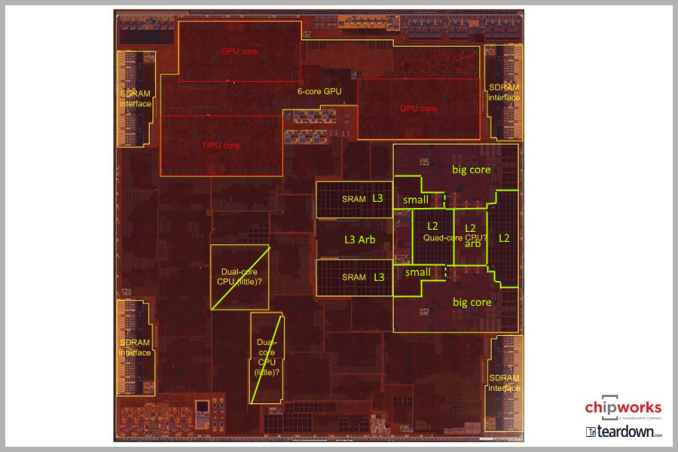
A10 Fusion's Floorplan (Special thanks to Chipworks)
While an in-depth look at A10 Fusion will have to wait until our seperate technology deep dive, we can still take a look at how performance has changed at a higher level. A10 Fusion's peak frequency is 2.3GHz, up from 1.8GHz on A9. This gives a theoretical improvement of 28% on its own, and the remainder will have to come from improvements to the architecture in Apple's (big) Hurricane cores. Based on our testing so far, Hurricane is not radically different from Twister (A9), but Apple has been making some optimizations. Meanwhile it should be noted that while A10 technically has four CPU cores – the two Hurricane cores and the two smaller cores – this is not a heterogeneous design, and only two cores are active at once. So for the purposes of high performance benchmarking, this means we're benchmarking the big cores nearly exclusively.
Anyhow, we've run our standard suite of benchmarks on the iPhone 7 and 7 Plus to see if A10 Fusion stands up Apple's performance claims.
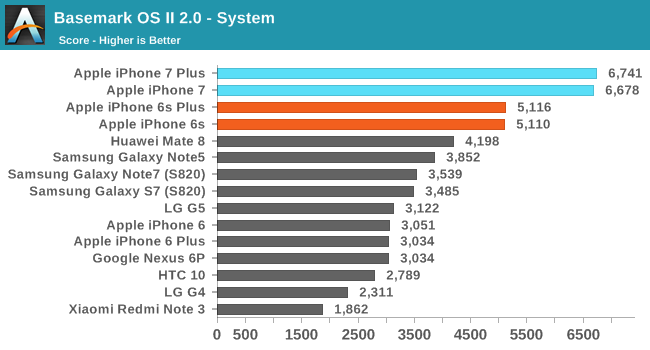
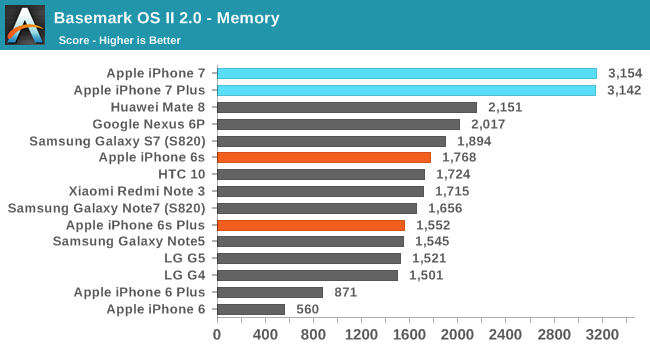
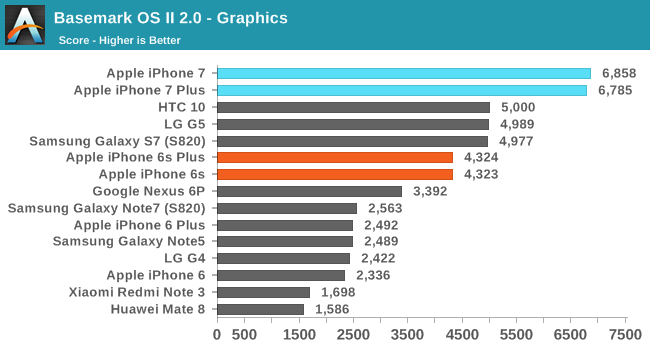
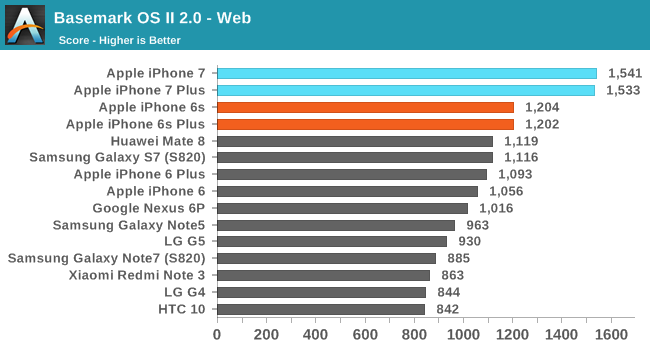

I've brought back BaseMark OS II for this review, although unfortunately the reason has less to do with wanting it back in the benchmark suite and more to do with there being very few cross-platform general system benchmarks nowadays. You can focus on the GPU, or the CPU, but the major system performance benchmark in mobile is PCMark and it remains exclusive to Android. BaseMark OS II is a pretty large optimization target now, and while it does test many aspects of the system it doesn't do so by directly simulating the tasks that a user would perform. Despite that, it helps in getting a holistic view of a device's performance by going beyond tests of a single component, so it's not without its uses.
The iPhone 6s and 6s Plus have remained the fastest overall devices in this test, so it's really just a matter of seeing how much Apple has improved. The latest generation of Android devices outpaced the GPU performance Apple's A9 SoC some time ago, so that's one area where Apple could stand to improve against the competition. As it turns out, they have. The iPhone 7 and 7 Plus show significant gains over their predecessors across the board. Performance in the system sub-test is up by 25-30%, and the graphics score is right in line with Apple's claimed 50% increase in performance. Web shows similar gains to system, which makes sense given that both are relatively CPU-bound.
The memory/storage test also shows a large improvement, which is interesting at first glance given that Apple didn't highlight any improvements in this area. However, this is just the result of the tested units being the 256GB model. On my retail iPhone 7 which is 128GB the memory score is essentially the same as the iPhone 6s which was also tested in a 128GB configuration. This comes down to the fact that these devices use a hybrid SLC/TLC storage solution, where the SLC storage can be used for writes and data can be moved later as needed. It's likely that on the 128GB iPhones the BaseMark OS II memory test is exceeding the size of the SLC cache, leading to lower scores based on the performance of the TLC NAND. On the 256GB iPhone the SLC cache is large enough to fit the entire data set used in the test, leading to a much higher score.
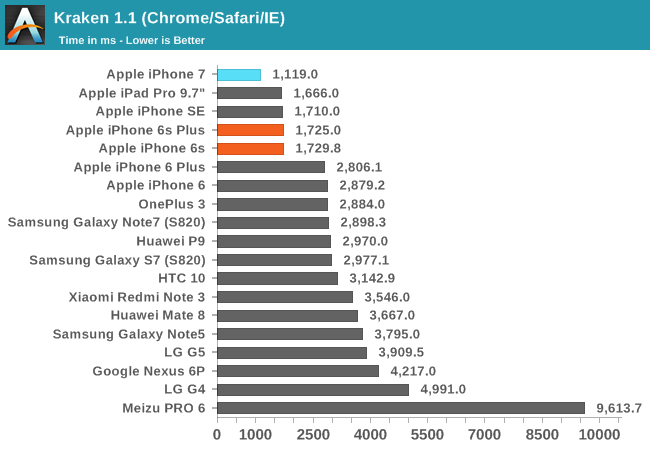
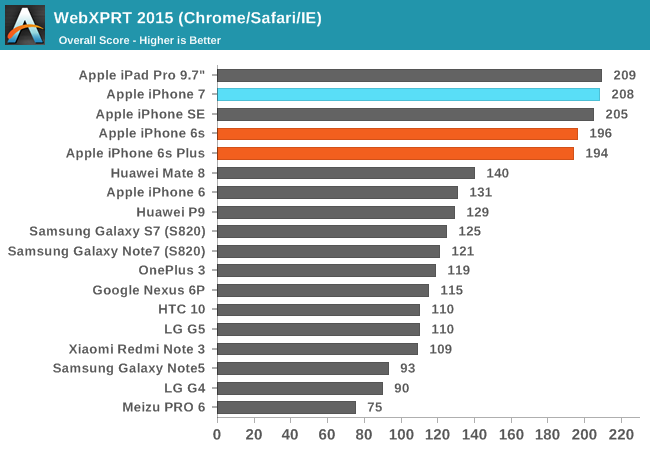
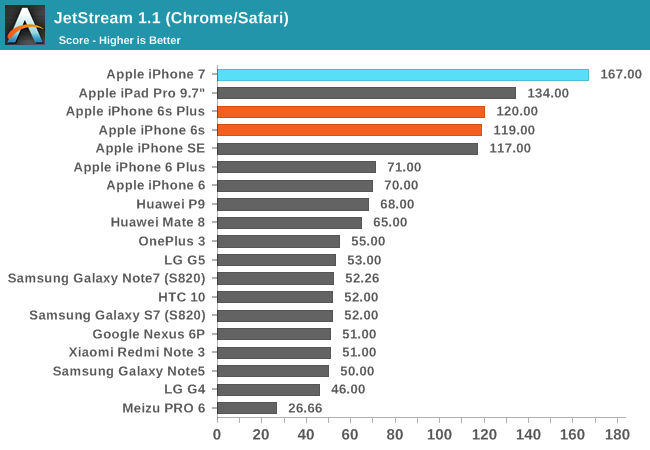
Web performance is an interesting case. While Apple's continued increases in single core CPU performance have benefited web performance with each generation, the truth is that improvements Mobile Safari's Nitro JavaScript engine have contributed a great deal as well. When looking at the charts you can see that there's a significant gap between the iPhone 7 and the next device, with the exception of WebXPRT where it's tied. What's more important than this gap is what the second device actually is. It's always another Apple device, and the same is true for the third device, and the fourth device, and so on. In Kraken and Jetstream the top seven devices on the chart are Apple's mobile devices, and the charts only have seven Apple devices in total. The Huawei Mate 8 is able to move ahead of the iPhone 6 in WebXPRT, but the gap between it and the iPhone 6s is still enormous. While Apple has continued to advance their web performance, it hasn't been with the immediate goal of beating the Android competition, as the best Android devices are still just trading blows with the iPhone 6.
WebXPRT is a small exception. As far as mobile benchmarks go, it's quite long and has short bursty workloads with pauses between each to simulate how a user would pause between different actions while using the browser. I suspect that in this case we're seeing the effects of A10 switching between its low power and high performance cores, causing parts of the test to be run on the little cores, which are not as performant. In fact, In the case of very quick actions that take only tenths or hundreths of a second to complete, it may not be possible to switch to the high performance cores before the operation has ended, causing the score to reflect the performance of the low power cores instead.
While it might seem reasonable to attribute the superior web performance of iOS devices to Apple's focus on improving single threaded CPU performance, the fact that Android devices with Cortex A72 CPUs are only matching Apple's A8 SoC shows that the gap is not only due to the CPU power available. Chrome's generally poor performance on Android is a significant limiting factor, and you can see in the chart how the improvement in Android device CPU performance over time has not translated into anything close to the sorts of gains that Apple has seen in the same period. While there are customized versions of Chromium like Snapdragon Browser that provide optimizations for a class of SoCs, it doesn't look like the gap between Android devices running Chrome and iOS devices running Mobile Safari is going to close any time soon, and if anything, it's only widening with each year.


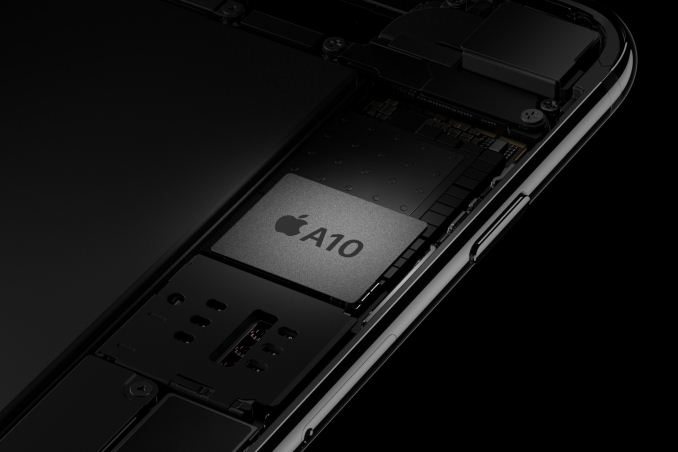








377 Comments
View All Comments
ycc - Monday, October 10, 2016 - link
Pretty much every updated program you use on a PC (Windows or Mac) will (should) be color managed, be in Chrome, Safari, Firefox, Edge, etc. In those cases the picture will just look a little less vibrant but the basic accuracy should be fine.The only issue is on mobile space, where Android devices don't support color management. I would imagine if you look at a jpg taken on an iPhone 7 with the DCI-P3 color space will look weird when Android tries to display it in its native color space without performing a conversion.
jlabelle2 - Wednesday, October 12, 2016 - link
"Pretty much every updated program you use on a PC (Windows or Mac) will (should) be color managed, be in Chrome, Safari, Firefox, Edge, etc"Absolutely not. NONE of the Windows Store app are for instance. The email applications / software or photo app (the default one) and Windows Photo Viewer are not. Also, IE has the issue of not applying the monitor ICC profile which create an issue for any wide gamut monitor.
Firefox was for a long time the only browser (with Safari on OS X) to manage properly the colors (assign sRGB to untagged image, read and convert image color space, use monitor ICC profile).
Because of that, wide color gamut screens on Windows (or Android) is still a huge problem making all the OS and applications colors appear oversaturated.
Ryan Smith - Tuesday, October 11, 2016 - link
It's something we're already working on as part of the deep dive.=)Bandur - Monday, October 10, 2016 - link
First page: "their first SoC with heterogeneous CPU cores"System Performance subpage : "this is not a heterogeneous design"
Is this meant to be like this?
Ryan Smith - Monday, October 10, 2016 - link
The hardware is heterogeneous, however the execution model is not. A heterogeneous execution model would have the system using all 4 CPU cores at the same time, instead of bouncing between the big and small cores based on power/perf needs.ikjadoon - Monday, October 10, 2016 - link
IMO, maybe this could've been clarified slightly. I had some trouble if the first page was a typo. 2 cents.Featherinmycap - Monday, October 10, 2016 - link
Fantastic review. I learned a great deal. I have been reading and enjoying this site for so long and the transition of the founders to Josh and Brandon has really gone smoothly. I am sorry the discussions have gone so far downhill from the early days of the site. This used to be an enthusiast site and now there seems to be so many people doing their upmost to pointlessly criticize how long it takes you to post something or what you decide to write about. I read many other tech blogs as well and these same people spew the same rhetoric on those sites as well. I am one loyal reader who says keep up the great work.mef - Monday, October 10, 2016 - link
Well said!techconc - Monday, October 10, 2016 - link
"While it’s not unusable by any means, you don’t need to have amazing vision to see the difference between 326 PPI and the 400-500 PPI of most Android devices and the iPhone Plus line."I realize this is the common mantra repeated by the spec conscious crowd, especially by Android fans. However, it simply isn't true. This can also be proven mathematically.... which is why I find random and unsupported comments like this to be rather disturbing on a respected technical site like Anandtech. Just a few points here....
1. If you understand the definition of normal (20/20) vision having the ability to discern 1 minute of arc, it can be mathematically proven that you can't see any signs of pixels at normal viewing distances.
2. This comment also assumes all things are equal between technologies. That is, take the Samsung Amoled displays that use Pentile based pixel arrangements. They use 1/3 less subpixels and need more full pixels in order to achieve the same level of sharpness.
3. Actual Apples to Apples comparisons.... I cannot see a quality difference between Apple's iPhone 6 (326 ppi) and 6 plus (401 ppi) screens. However, I can see a quality difference between these and the iPad's 264 ppi screen.
3a. I've seen people try to demonstrate a difference using text. They've mistaken a lighter font on an Android phone for higher resolution. You need to make a true comparison with the same programs, the same OS and the same font rendering systems to make the proper conclusion.
At the end of the day, nobody is looking at an iPhone screen and saying this is great.. I just wish it were sharper. This is only an issue for people counting specs who don't know what they're looking at.
grayson_carr - Monday, October 10, 2016 - link
Depends on your definition of normal viewing distance. At an arms length (2+ feet), I definitely can't tell the difference between a 4.7 inch iPhone and the 5.5 inch 1080p iPhone or a QHD Android phone, but when I bring the phone in to about 1 foot from my face, as I often do when sitting down or laying in bed, the difference is obvious.